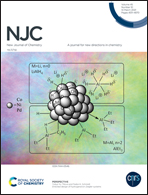An imine linked fluorescent covalent organic cage: the sensing of chloroform vapour and metal ions, and the detection of nitroaromatics†
Abstract
A triphenylamine-derived fluorescent covalent organic cage molecule (F-COC) shows enhanced emission when doped in polystyrene (PS) upon exposure to chloroform vapours. A systematic investigation of the fluorescence emission intensity of F-COC in various solvents reveals the gradual enhancement of the emission intensity as a function of the dielectric constant of the solvent; a maximum is observed for chloroform and this gradually decreases in solvents with a higher dielectric constant. The probable reason for the selective high emission of F-COC in chloroform solution or vapor is linked to the orientation polarizability of chloroform, which changes the F-COC molecular orientation. Computational modelling of the model structures illustrates that the optimized excited state energy as a function of the dielectric constant of the solvent deviates from the usual trend, and the specific role of hydrogen bonding interactions with chloroform was elucidated. Picric acid (PA) detection was studied using an F-COC fluorescence quenching technique in solution. The quenching was observed to be a static process, confirming that fluorescence quenching occurs in the ground state. Enhanced solid-state fluorescence arose from the complexation of F-COC with metal ions such as Zn2+ and Cu2+, as well as harmful Cd2+ and Pb2+ ions.



 Please wait while we load your content...
Please wait while we load your content...